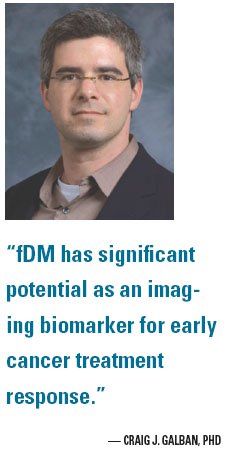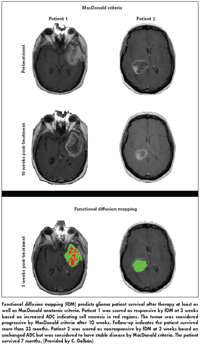MR brain mapping assesses response to glioma therapy
Brain tumor patients receiving standard radiation therapy must wait up to 10 weeks for follow-up CT or MR to determine whether the treatment is working, based on the established MacDonald criteria for assessing treatment.
ABSTRACT: Diffusion mapping matches accuracy of standard technique weeks before assessment of therapeutic response is usually available.

Brain tumor patients receiving standard radiation therapy must wait up to 10 weeks for follow-up CT or MR to determine whether the treatment is working, based on the established MacDonald criteria for assessing treatment.
The days of this treatment paradigm may be numbered, however, if the work of Brian Ross, PhD, and colleagues in the radiology department at the University of Michigan gains general support. They propose serial functional MR diffusion mapping performed a week before treatment and then 3 weeks after the initiation of radiation therapy to give the oncologist an earlier and ongoing measure of treatment response and assessments of patient survival.
Craig J. Galbn, PhD, an assistant professor with the Michigan group, presented results at the 2008 ISMRM meeting based on experience with brain tumor patients. They showed that the MR diffusion mapping technique gave their physicians earlier feedback about the effectiveness of therapy.
The functional diffusion maps segment the tumor into three categories: red voxels for tumor volumes where the apparent diffusion coefficient (ADC) increased significantly following treatment, blue voxels where ADC decreased significantly, and green voxels where ADC was unchanged.
“We are interested in the volume fraction of increasing ADC in the tumor, which is encoded as red voxels on the fDM,” Dr. Galbn said.
The prospective trial involved 70 patients. Of that total, 67 had grade 3-4 gliomas that were

treated with radiation therapy or both radiation and chemotherapy. Sixty of these were evaluated with functional brain mapping at weeks 1, 3 and 10 post-treatment initiation. Receiver operator characteristic curve analysis found that functional brain mapping performed 3 weeks after the start of treatment produced the most accurate results of the three post-treatment studies. That evaluation was 68.8% sensitive and 85% specific for predicting 1-year survival (P < .0002).
The ability of functional brain mapping to differentiate among responders and nonresponders after 3 weeks of treatment was similar to results produced with the conventional MacDonald criteria after 10 weeks (see Figure). Dr. Galbn added, “fDM has significant potential as an imaging biomarker for early cancer treatment response.”
Using functional mapping data gathered 3 weeks after the initiation of therapy, patients who had a volume fraction of red that made up more than 5% of the tumor volume survived five times longer than patients who had a volume fraction of red that was less than 5% of tumor volume, he said. The next step is a multicenter clinical trial to validate this single site prospective trial (Hamstra et al: J Clin Oncol 26:3387-3394, 2008).
This article is adapted from ONI’s sister publication Diagnostic Imaging (August 2008).